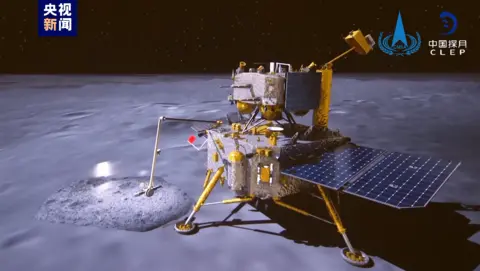 CNSA
CNSAChina says its lunar probe has successfully taken off from the far side of the moon to begin its journey back to Earth carrying the first samples ever collected from the region.
State media says the collecting module of the Chang’e-6 craft lifted off about 07:38 on Tuesday (23:38 GMT Monday) to begin the journey back.
On Sunday, the robot landed in a giant crater close to the moon’s south pole in a world-first feat celebrated by the international science community.
China is the only country to have landed on the far side of the moon, having also done so before in 2019.
The Chinese National Space Administration (CNSA) described the mission’s landing and lift-off as an ”unprecedented feat in human lunar exploration”.
The far or “dark” side of the moon – which faces away from Earth – is technically challenging to reach due to its distance, and its difficult terrain of giant, deep craters and few flat surfaces.
Space officials have had to use a satellite to direct and maintain communications with the Chang’e-6 craft.
China aims to be the first country to bring back rock and soil samples from the far side of the moon, which scientists say could be very different from rock formations on the near side.
State media published videos from China’s space agency showing the Chang’e 6 craft sticking out a little arm and waving the Chinese flag after it collected the precious samples.
It is China’s sixth mission to the moon, named after the moon goddess Chang’e in Chinese mythology.
Successful mission so far
The CNSA announced the sampling’s conclusion on Tuesday saying the craft had “withstood the test of high temperature on the far side of the moon” and was now beginning its return.
Its ascender module successfully “lifted off from the lunar surface” on Tuesday with samples in a metal vacuum container.
After taking off, the module then entered a “pre-set orbit around the moon”. The container will be transferred to a re-entry capsule set to return to Earth, landing in the desserts of Inner Mongolia around 25 June.
Chang’e-6 had spent two days gathering rocks and soil – using a mechanical arm and drill to collect about 2kg (4.4lb) of material.
It has been based in the South Pole-Aitken basin – a gigantic crater on the moon’s far side which is one of the largest known in the solar system.
Directing the craft there had been fraught with risks because it is very difficult to communicate with spacecraft once they reach the far side of the Moon.
China’s space authorities described the operation as involving “many engineering innovations, high risks and great difficulty”.
Scientists are excited about the samples which could potentially be from some of the Moon’s oldest rocks.
Those in China will be given the first chance to analyse the rocks, and later researchers around the world will be able to apply for the opportunity too.
“Everyone is very excited that we might get a look at these rocks no-one has ever seen before,” Prof John Pernet-Fisher, a lunar geology specialist at the University of Manchester told the BBC last week.
He said the chance to analyse rock from a completely different area of the Moon could answer fundamental questions about how planets form.
The Moon’s South Pole is the next frontier in lunar missions – countries are keen to understand the region because there is a good chance it has ice.
Access to water would significantly boost the chances of successfully establishing a human base on the Moon for scientific research.
This is China’s second mission to collect samples from the moon- but it is the first aimed at extracting them from the far side.
In 2020, its Chang’e-5 craft brought back 1.7kg of material from an area called Oceanus Procellarum on the Moon’s near side.
And the year prior, China became the first country to reach the far side of the moon with the landing of its Chang’e-4.
China is planning three more uncrewed missions this decade as it looks for water on the Moon and investigates setting up a permanent base there. The country already has its own space station known as Tiangong or Heavenly Palace.
Beijing’s broader strategy aims to see a Chinese astronaut walk on the moon by around 2030.
The US also aims to put astronauts back on the moon, with Nasa aiming to launch its Artemis-3 mission in 2026.


إرسال تعليق